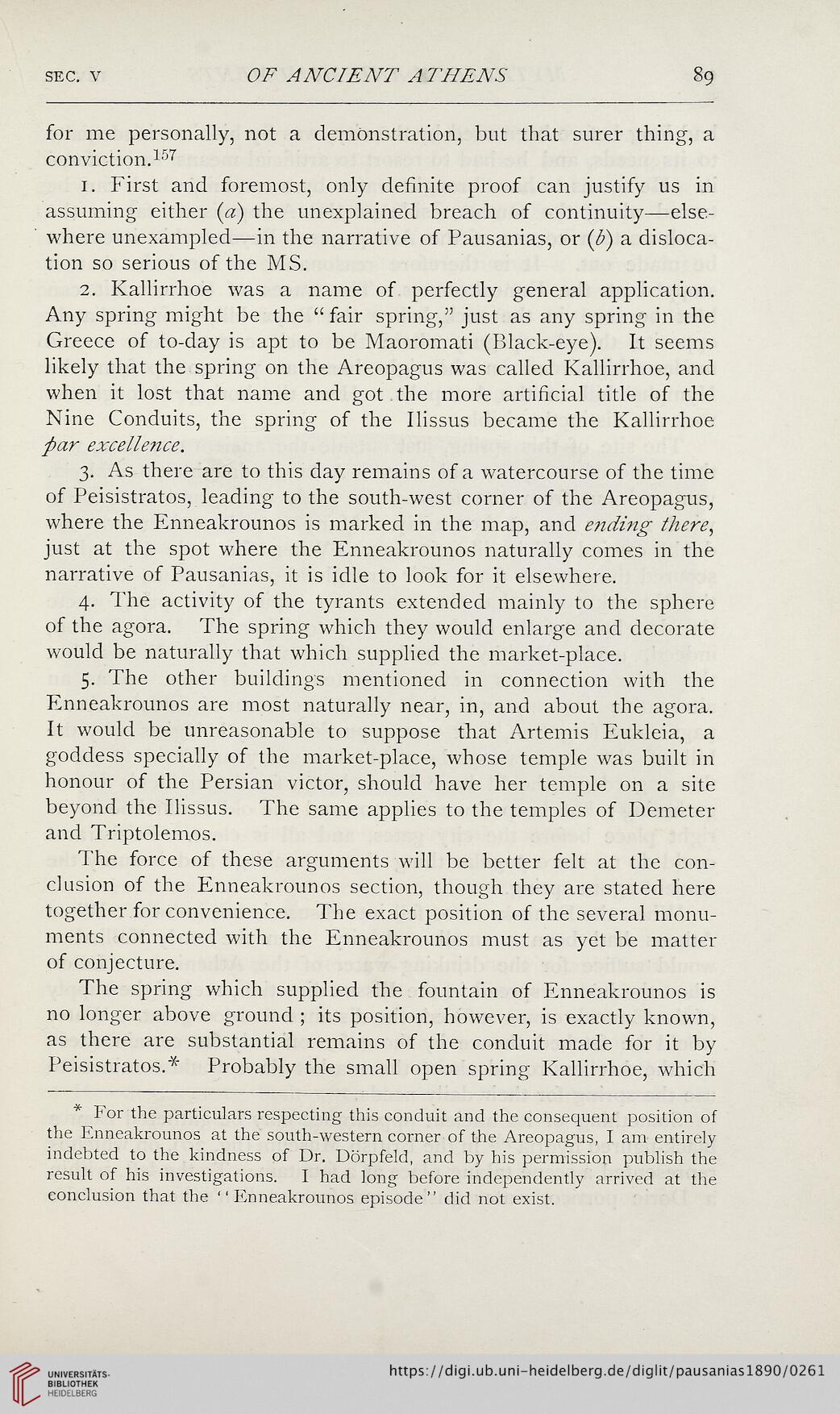SEC. V
OF ANCIENT ATHENS
89
for me personally, not a demonstration, but that surer thing, a
conviction.157
1. First and foremost, only definite proof can justify us in
assuming either («) the unexplained breach of continuity—else-
where unexampled—in the narrative of Pausanias, or (b') a disloca-
tion so serious of the MS.
2. Kallirrhoe was a name of perfectly general application.
Any spring might be the “ fair spring,” just as any spring in the
Greece of to-day is apt to be Maoromati (Black-eye). It seems
likely that the spring on the Areopagus was called Kallirrhoe, and
when it lost that name and got the more artificial title of the
Nine Conduits, the spring of the Ilissus became the Kallirrhoe
par excellence.
3. As there are to this day remains of a watercourse of the time
of Peisistratos, leading to the south-west corner of the Areopagus,
where the Enneakrounos is marked in the map, and ending there,
just at the spot where the Enneakrounos naturally comes in the
narrative of Pausanias, it is idle to look for it elsewhere.
4. The activity of the tyrants extended mainly to the sphere
of the agora. The spring which they would enlarge and decorate
would be naturally that which supplied the market-place.
5. The other buildings mentioned in connection with the
Enneakrounos are most naturally near, in, and about the agora.
It would be unreasonable to suppose that Artemis Eukleia, a
goddess specially of the market-place, whose temple was built in
honour of the Persian victor, should have her temple on a site
beyond the Ilissus. The same applies to the temples of Demeter
and Triptolemos.
The force of these arguments will be better felt at the con-
clusion of the Enneakrounos section, though they are stated here
together for convenience. The exact position of the several monu-
ments connected with the Enneakrounos must as yet be matter
of conjecture.
The spring which supplied the fountain of Enneakrounos is
no longer above ground ; its position, however, is exactly known,
as there are substantial remains of the conduit made for it by
Peisistratos.* Probably the small open spring Kallirrhoe, which
* For the particulars respecting this conduit and the consequent position of
the Enneakrounos at the south-western corner of the Areopagus, I am entirely
indebted to the kindness of Dr. Dbrpfeld, and by his permission publish the
result of his investigations. I had long before independently arrived at the
conclusion that the ‘‘Enneakrounos episode” did not exist.
OF ANCIENT ATHENS
89
for me personally, not a demonstration, but that surer thing, a
conviction.157
1. First and foremost, only definite proof can justify us in
assuming either («) the unexplained breach of continuity—else-
where unexampled—in the narrative of Pausanias, or (b') a disloca-
tion so serious of the MS.
2. Kallirrhoe was a name of perfectly general application.
Any spring might be the “ fair spring,” just as any spring in the
Greece of to-day is apt to be Maoromati (Black-eye). It seems
likely that the spring on the Areopagus was called Kallirrhoe, and
when it lost that name and got the more artificial title of the
Nine Conduits, the spring of the Ilissus became the Kallirrhoe
par excellence.
3. As there are to this day remains of a watercourse of the time
of Peisistratos, leading to the south-west corner of the Areopagus,
where the Enneakrounos is marked in the map, and ending there,
just at the spot where the Enneakrounos naturally comes in the
narrative of Pausanias, it is idle to look for it elsewhere.
4. The activity of the tyrants extended mainly to the sphere
of the agora. The spring which they would enlarge and decorate
would be naturally that which supplied the market-place.
5. The other buildings mentioned in connection with the
Enneakrounos are most naturally near, in, and about the agora.
It would be unreasonable to suppose that Artemis Eukleia, a
goddess specially of the market-place, whose temple was built in
honour of the Persian victor, should have her temple on a site
beyond the Ilissus. The same applies to the temples of Demeter
and Triptolemos.
The force of these arguments will be better felt at the con-
clusion of the Enneakrounos section, though they are stated here
together for convenience. The exact position of the several monu-
ments connected with the Enneakrounos must as yet be matter
of conjecture.
The spring which supplied the fountain of Enneakrounos is
no longer above ground ; its position, however, is exactly known,
as there are substantial remains of the conduit made for it by
Peisistratos.* Probably the small open spring Kallirrhoe, which
* For the particulars respecting this conduit and the consequent position of
the Enneakrounos at the south-western corner of the Areopagus, I am entirely
indebted to the kindness of Dr. Dbrpfeld, and by his permission publish the
result of his investigations. I had long before independently arrived at the
conclusion that the ‘‘Enneakrounos episode” did not exist.




